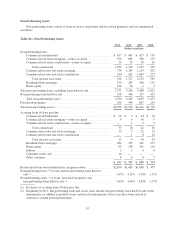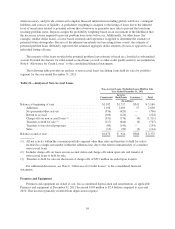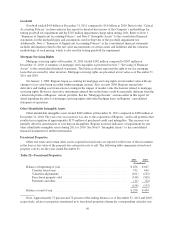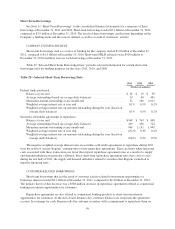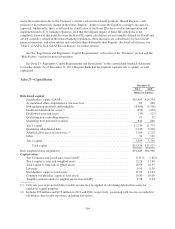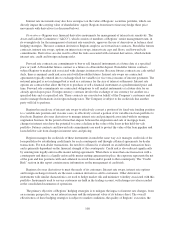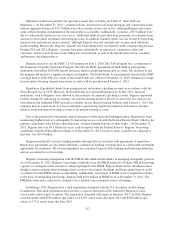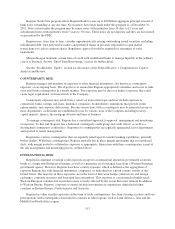Regions Bank 2011 Annual Report Download - page 127
Download and view the complete annual report
Please find page 127 of the 2011 Regions Bank annual report below. You can navigate through the pages in the report by either clicking on the pages listed below, or by using the keyword search tool below to find specific information within the annual report.
The minimum standard for the ratio of total capital to risk-weighted assets is 8 percent. At least 50 percent
of that capital level must consist of common equity, undivided profits and non-cumulative perpetual preferred
stock, senior perpetual preferred stock issued to the U.S. Treasury under the Capital Purchase Program, minority
interests relating to qualifying common or noncumulative perpetual preferred stock issued by a consolidated U.S.
depository institution or foreign bank subsidiary, less goodwill, disallowed deferred tax assets and certain other
intangibles (“Tier 1 capital”). The remainder (“Tier 2 capital”) may consist of a limited amount of other preferred
stock, mandatorily convertible securities, subordinated debt, and a limited amount of the allowance for loan
losses. The sum of Tier 1 capital and Tier 2 capital is “total risk-based capital” or total capital. However, under
the Collins Amendment, which was passed as a section of the Dodd-Frank Act, trust preferred securities will be
eliminated as an element of Tier 1 capital. This disallowance of trust preferred securities will be phased in from
January 1, 2013 to January 1, 2016. Debt or equity instruments issued to the Federal government as part of the
CPP are exempt from the Collins Amendment. As of December 31, 2011, Regions had $846 million of trust
preferred securities that are subject to the Collins Amendment and $3.5 billion of preferred equity that is exempt
from the Collins Amendment.
The banking regulatory agencies also have adopted regulations that supplement the risk-based guidelines to
include a minimum ratio of 3 percent of Tier 1 capital to average assets less goodwill and disallowed deferred tax
assets (the “Leverage ratio”). Depending upon the risk profile of the institution and other factors, the regulatory
agencies may require a Leverage ratio of 1 percent to 2 percent above the minimum 3 percent level.
In recent years, the Federal Reserve and banking regulators began supplementing their assessment of the
capital adequacy of a bank based on a variation of Tier 1 capital, known as Tier 1 common equity. This measure
has been a key component of assessments of capital adequacy under the Comprehensive Capital Analysis and
Review (“CCAR”) process. While not currently codified 1, analysts and banking regulators have assessed
Regions’ capital adequacy using the Tier 1 common and/or the tangible common stockholders’ equity measure.
Because tangible common stockholders’ equity and Tier 1 common equity are not formally defined by GAAP or
codified in the federal banking regulations, these measures are considered to be non-GAAP financial measures
and other entities may calculate them differently than Regions’ disclosed calculations (see Table 2 “GAAP to
Non-GAAP Reconciliation” for further details).
The Dodd-Frank Act requires the Federal Reserve to impose more stringent capital requirements on bank
holding companies with assets of $50 billion or more. Consequently, as part of Regions’ annual CCAR, Regions
must submit its annual capital plans to the Federal Reserve. As part of the CCAR, Regions is required to submit
four scenarios including the company’s baseline forecast, the Federal Reserve’s baseline outlook, the Company’s
stress case and the Federal Reserve’s stress case. Regions is required to maintain its capital levels above each
minimum regulatory capital ratio and above a Tier 1 common ratio of 5 percent on a pro forma basis under
expected and stressful conditions throughout a certain time period horizon. Any capital actions requested by
Regions must be submitted to the Federal Reserve for approval. The Federal Reserve has committed to
responding to Regions capital plans by mid-March 2012. The Federal Reserve intends to publish the results of
the supervisory stress test component of CCAR for Regions and all companies that are participating.
Regions is evaluating the anticipated impact of Basel III based on the proposal by the Basel Committee on
Banking Supervision, which will begin in 2013 and is expected to be fully phased-in on January 1, 2019. The
Company’s estimated Tier 1 capital and Tier 1 common ratios as of December 31, 2011, based on Regions’
current understanding of the guidelines, were approximately 11.39 and 7.70 percent, respectively, which are
above the Basel III minimums of 8.5 percent for Tier 1 capital and 7 percent for Tier 1 common. Based on
Regions’ understanding of the calculation for the liquidity coverage ratio under Basel III, Regions currently
1On December 20, 2011 the Board of Governors of the Federal Reserve released a Notice of Proposed
Rulemaking on enhanced capital standards and early remediation requirements mandated by sections 165
and 166 of the Dodd-Frank Act. If enacted as proposed this would codify the calculation of Tier 1 Common
Capital.
103


